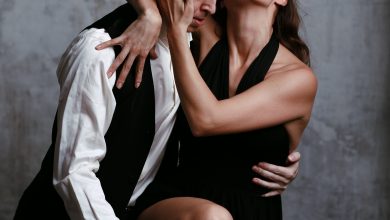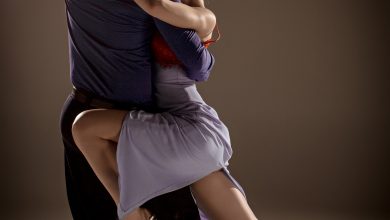Volcada
A tango step that uses the methodology and principles of ‘Apilado’ is the Argentine Volcada. It is a shared axis movement where the two partners lean towards each other in a special kind of off-balance situation. The top of the axis points towards the partner.The Volcada (tilt, to tip over) is when the leader and follower both lean forward, off-axis, into one another. Volcadas became a trademark of Carlos Gavito because he used them so frequently. The extent of the volcada depends on style and preferences. For example, in the Calesita, the leader can play with the degree of the Volcada. The Leader should be careful to protect the follower’s back performing Volcadas! The correct use of the abdominal muscles by the follower also helps.
Here are some great videos to watch:
- Basic Volcada and Volcadas to Both Sides
Basic volcadas and volcadas to both sides of the embrace. - Volcadas Part 1: Basic Circular and Linear Volcadas
A volcada (tilt, to tip over) is when the leader and follower both lean forward, off-axis, into one another. This is also referred to as in carpa (tent). - Linear Volcadas from Back Crosses
This class primarily focused on linear Volcadas initiated from back crosses. - Volcadas from the Mirror Step
Volcadas from a mirror step.
- Giro with Sacada to Back Cross to Volcada
A turn (giro) to the close side of the embrace with a sacada and resolving in a Volcada.
Volcada / Carousel combination
Multiple Volcada sequence
Cut Ocho-Boleo-Volcada
Overturned Ochos
Back & Forward Volcadas
A Volcada is a “tipping” or “dumping” motion, where the follower is tipped off-axis and then returned to axis. Usually this includes the manipulation of the follower’s leg–a sweep movement created by the off-axis motion.
What does a volcada look like?
There are many different shapes for a Volcada. The follower’s free leg is used by the leader to draw a shape on the floor. This shape can be a V-shaped wedge; a big sweeping C, ending with going to a cruzada shape; or a big sweeping circle if the leader also rotates the couple. Part of the fun of a Volcada, is that the leader gets to play with the shape of the movement.
Leader’s Volcada technique:
1. Stay as much on axis as possible: The Volcada is most striking when the follower does most of the tilting.
2. Use your body to tell the follower not to switch feet by a subtle lift of the embrace. This gives the follower’s leg room to swing. The Leader gives a tight embrace with a slight lift. The Leader creates the Volcada feeling by supporting and lifting the Follower more. The Leader needs to be up not down. The Leader controls how loose or tight the the Follower’s back cross is.
3. Think of the follower’s support leg like the point of a compass: all the movement is happening around that leg point, and returns there before moving to the next step.
4. Once the leader has lifted the follower, move away from the follower to create the tipping motion. Take relatively small steps away, but with your entire body (don’t take your feet and leave your head). Leader does not go back on his axis, but maintains a forward and upward intention in his chest, as does Follower, so both dancers maintain good connection to each other.
Leader should not go down at all, and really be forwardly and upwardly intended in his chest. For the Leader’s footwork, he goes back on his right foot while still keeping a forward intention in his chest, not going back to vertical axis.
5. Catch the pendulum swing of the follower’s leg (their legwill be swinging around and towards the leader, or dropping directly towards the leader), and draw a shape that ends with the follower’s free foot passing by the support foot.
6. Release the lift of the embrace before asking the follower to take another step. Do not release the lift early, or the follower’s free foot gets stuck out in the swing and can’t be collected elegantly under them.
8. As soon as the leader feels the follower’s weight change at the cruzada, the leader can step forward.
9. Exit: It is especially important during those steps that the leader is on balance and grounded for those steps, in case the follower needs help.
Follower’s Volcada technique
No matter how well the leader leads this move, the follower must pay attention to their technique with correct posture and balance.
1. Keep the back and spine stretched: Volcada injuries can occur when the follower sags into the move. Core muscles and abdominal muscles should be lifted and strong.
2. Keep your hips aligned over your support leg.
3. When the leader tips the follower forward, the follower should try to be even longer and tall than when on axis. Don’t let the heel come off the floor on the support leg unless the Volcada is so big that I have no choice
4. Release the free leg as deeply in the center of your hip joint as possible. The shape of the volcada is determined by the leader’s path of the follower’s leg. If the follower stays stretched in their spine and support leg, the “free” leg will naturally have space to slide on the floor.
5. All Volcadas are determined by the step that precedes the Volcada. If you do the version that we learned that starts with a side step, the volcada will be V-shaped. If you start with a small boleo, the volcada will be more circular.
6. When the leader places the follower’s foot and releases the lift on the follower’s body, make sure to stay in contact with the leader. It’s not necessary to immediately return to on-axis; it may take a step of two.
7. By being stretchy and maintaining your axis even off-axis, you make this move easy for the leader. Even a follower twice my size is light if following correct technique.
8. The Follower should stay in front of the Leader as much as possible.
9. Follower should not hesitate, and should have power in the supporting leg, dig down into the floor to push up and against the Leader. Follower should use relationship with the floor to stay grounded.
10. Follower’s body should be stable and strong, with core muscles engaged so that the follower’s body does not collapse against or onto the Leader.
11. The Follower’s left leg is free, but controlled not loose. The follower needs to pay attention to how it moves, and can project the foot forward a lot if it’s a big volcada. The follower should pay attention and think about how the free foot unwinds, trying to make it as elegant, articulate and stable as possible.
12. After the volcada, the Follower should ease back into her normal position, rolling through her feet.
Because this move requires being off-balance and supporting another person’s weight, it is important to safeguard the back. Leaders: lift from your legs, not your back. Followers: work your abs to save your back.
The volcada requires that the lead takes the follower off her axis by the creation of a formation called the Carpa (tent), and whilst the volcada is executed, he supports the follower’s weight. The follower needs to keep her spine extended, with the free leg kept loose so that as the lead pivots, his energy is reflected into the follower’s leg. The follower’s free foot is used to draw a shape on the floor as the lead rotates around her (she is kept in the centre), and the sketching of this shape should arise directly by the action and movements of the lead.
There is also a move known as the Volcada Plus:
From the simple tight back volcada, the Leader brings his feet together, takes his axis back and down, which causes the Follower to do a split with her legs, and then he drives her left leg back into the forward cross.
The Follower uses her supporting right leg to have lift and have the left leg open up out to the left side.
Back & Forward Volcadas
Volcada with Sacada start
Stage Volcada



